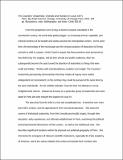The Courtiers’ Anatomists: Animals and Humans in Louis XIV’s Paris.
Author(s)
Ritvo, Harriet
DownloadRitvo_Guerrini.ehrev.july16.pdf (107.0Kb)
OPEN_ACCESS_POLICY
Open Access Policy
Creative Commons Attribution-Noncommercial-Share Alike
Terms of use
Metadata
Show full item recordAbstract
rom the perspective even of stay-at-home European naturalists in the seventeenth century, the world kept getting bigger as increasing animal, vegetable, and mineral evidence of its breadth and variety poured into metropolitan centers. At the same time, the technology of the microscope and the virtuoso practice of dissection (of living animals as well as corpses—Anita Guerrini argues that these practices were perceived as less distinct by her subjects, and by their private and public audiences, than has subsequently become the case) turned the attention of anatomists to things that were small and hidden. Written with interdisciplinary erudition and insight, The Courtiers’ Anatomists persuasively demonstrates that these modes of inquiry were neither independent nor inconsistent; on the contrary, they could be pursued at the same time by the same individuals. As her subtitle indicates, Guerrini does not attempt to survey Enlightenment science. Instead she focuses on a particular group of anatomists who were based in Paris and who enjoyed the support of Louis XIV.
Date issued
2017Department
Massachusetts Institute of Technology. Department of Humanities. History SectionJournal
Environmental History
Publisher
Oxford University Press
Citation
Ritvo, Harriet. “The Courtiers’ Anatomists: Animals and Humans in Louis XIV’s Paris. By Anita Guerrini.” Environmental History 22, 1 (October 2016): 165–167 © 2016 The Author
Version: Author's final manuscript
ISSN
1084-5453
1930-8892